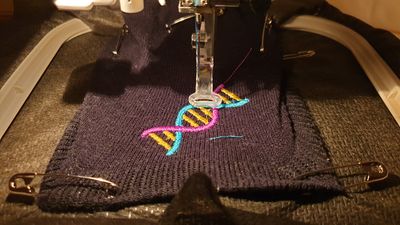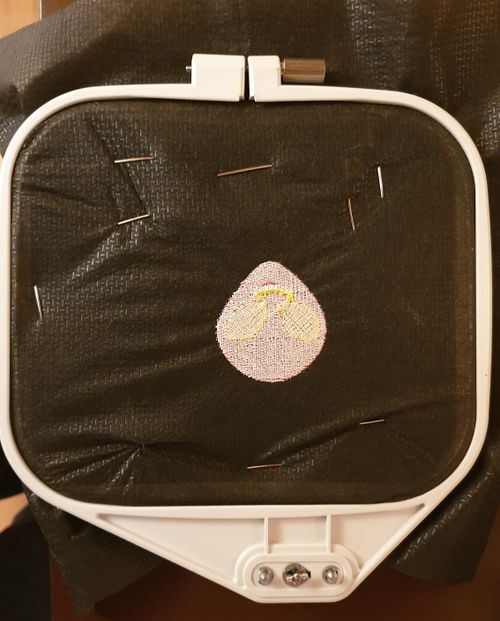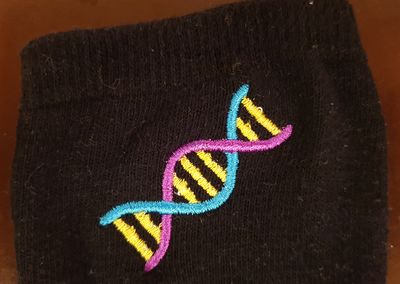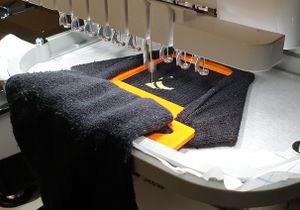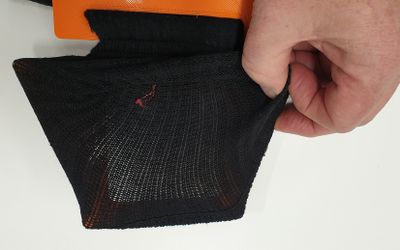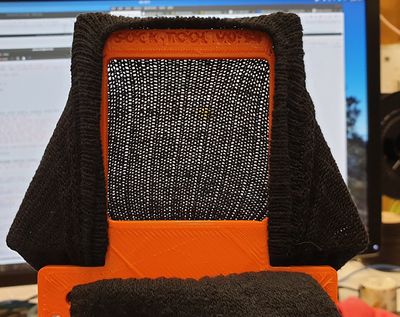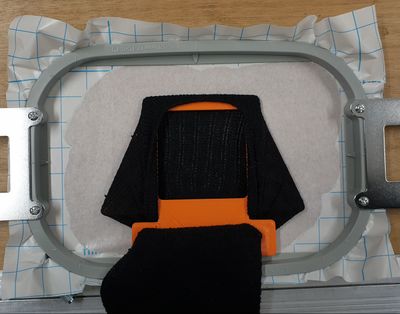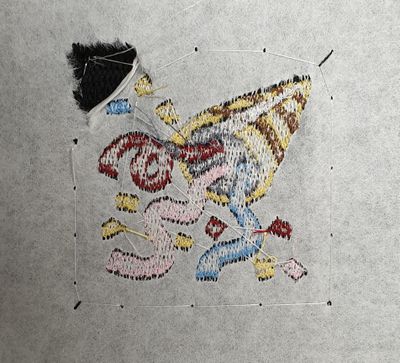Embroider on socks
The problem
In order to embroider on a sock, one has to make sure that the machine only stitches on one side of the sock.
This is a very easy task if your machine has a small free arm, like all professional and semi-professional machines do. Sometimes, small frames must be bought as an add-on, e.g. the "Compact Frame Set" with the "E" Frame holder for the PR1050X.

In this article we will present three methods. The first only requires safety pins, the 2nd "sock tool" method and the 3rd "sock frame" a 3D printer or a laser cutter. The "sock frame" method also requires measuring out a hoop and changing parameters of a 3D model.
Embroider a sock using safety pins
The safety pin method is fairly easy to achieve, but it takes some time. The basic principle is to pin a roughly 5cm x 5cm area to the stabilizer for embroidery and pull the tissue that would sit underneath away.
1) Hoop a strong stabilizer, preferably polyester. Tighten well (but without breaking the frame).
2) Optional: If your frame is thin or broken, it is advisable to fix the stabilizer with safety pins to the frame (c.f. the pictures below where you can see that the stabilizer has been attached at the top and bottom).
3) Attach the top of the sock like in the next picture below
- Start by fixing the 2 corners of the side you want to embroider, so the top/front of the sock.
- Then fix, the 2 opposite corners as in the following image.
- In both cases, pull the sock slightly, but not too much, otherwise the embroidery will fold.
4) Pull the surface to be embroidered in three directrions and fix with safety pins.
- It is important that the fabric to be embroidered is flat and that nothing gets stuck underneath (otherwise you won't be able to fit in your sock). Pinch the fabric about halfway between the bottom (c.f. point 3) and the top and pull well !
- To attach this pulled embroidery surface you need at least three pins: One at the bottom, one on the left and one on the right. The following picture already shows a pin on the left and on the right. On the left you can see the head of a pin that was used in step 3.
Below is a decent hooping result (our second attempt). We can see the surface to be embroidered. Underneath there is only the stabilizer.
5) Stitch ....
Advice:
- Obviously it is difficult to do precision embroidery. So you have to either work with airy designs or overlap embroidery surfaces to avoid gaps. Also avoid too tight satin stitches (2mm is a minimum).
- Do not exceed a surface of 5x4cm for an adult sock.
Results:
Embroider with the sock tool
The sock tool does basically the same thing as the safety pin method. It clears a 50 x 50 mm space for embroidery. Instead of pulling various bits of the sock with safety pins, you wrap the sock around the tool as we shall explain:
Choose your sock tool
Firstly you need a sock tool. You can 3D print it, laser cut it (faster) or order it from an online printing/lasering service. In order to produce the right custom size for your needs, install OpenScad (download) (a free CAD programming tool). Once installed:
- Open the sock-tool.scad file
- Hit F5
- Open the composer panel (Menu View -> Untick "Hide Customizer".
- Configure your options. The default values work with medium man size (EU 41)
As of version 0.94, the configuration interface looks like this:
There are various minor options, e.g. add some writing on top or create holes
Before you print, laser or buy a sock tool we suggest that you print out a paper version, then evaluate if your socks fit onto your configuration. To print out a paper version, untick "MODE 3D" in the composer panel. Then hit F6 and export the file as SVG. The SVG version then can be used with a laser cutter.
For 3D printing, keep "MODE 3D", hit F6, the export as STL. This object can be printed easily. I print it with fat 0.56 layers and a 0.7mm nozzle. It takes a bit less or a bit more than an hour, depending on its size and speed settings.
Embroidery design for socks
We suggest to avoid dense small items, e.g. leave eyes out or make them bigger.
You must adapt your design to the size of the hole. We suggest to respect a safety margin of at least 1.25cm on each side, that is length = hole size - 2.5cm.
- For a 70 x 70 tool (medium socks), do not exceed 45 x 45mm
- For a 60 x 60 tool (smaller socks), keep it down to 35 x 35 mm
For additional safety we also encourage stitching some kind of fixing line first.
Use of the sock tool
Step 1: Attaching the sock to the sock tool
As describe above, firstly select the right sock tool size, e.g. the default settings probably generate a tool with a 7cmx7cm hole, a 1cm border and 3.7cm wings that fits medium sock size well.
Insert the sock
- Push the upper end of the sock through the mouth
Attach the back side of the sock to the bottom and the front side to the top as seen in the next picture
- Start with either the bottom or side and then do the rest.
Pull tissue underneath over the wings
- Avoid damaging the sock
Pull the sock down
- Once attached to the side, gently pull the sock down, i.e. through the hole
Adjust
- Make adjustments until the surface to embroider looks good
Flatten
- Pull additional tissue through the sock hole, i.e. try to make the whole package as flat as possible.
Step 2 Prepare the embroidery hoop
- Insert auto-adhesive stabilizer sticky side up into a hoop that is bigger than the sock tool
- Remove the protection of the stabilizer
- Put the sock tool as much in the center of the hoop as you can
- (Option) secure with 2 safety pins
Step 3 Position the design in the embroidery interface
- Insert the hoop into the machine and make sure that machine is aware of the hoop size
- Load the design into the machine
- Verify hoop size again and change if necessary (some machines do not behave)
- Position the design so that its center is the center of the hole.
- Make sure that your machine stitches the design around the center.
- Verify if your design is well positioned by any offered means, e.g. have the machine outline the design. Adjust if necessary, i.e. move the design in the control screen.
Step 4 Stitch
- If you are confident of your positioning, stitch a hold down rectangle. Before doing so make sure that the line is close to the design (that can be defined in the settings). Else do not do that, since your foot or needle may run into a wall.
Step 5 Remove the sock





